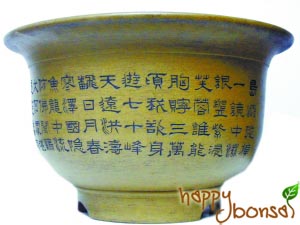 It is said that if we use a Yixing zisha teapot for many years, we can brew tea just by pouring boiling water into the empty pot. Highly praised for its porous nature, which works wonders in absorbing the flavor of tea, Yixing clay makes awesome teapots, while at the same time, is also an excellent material for making bonsai pot.
It is said that if we use a Yixing zisha teapot for many years, we can brew tea just by pouring boiling water into the empty pot. Highly praised for its porous nature, which works wonders in absorbing the flavor of tea, Yixing clay makes awesome teapots, while at the same time, is also an excellent material for making bonsai pot.
Yixing clay potteries are usually left unglazed. With Yixing clay’s porous nature, Yixing bonsai pot is excellent in moisture absorption and ventilation, very suitable for the growth of bonsai trees. Moreover, the unpretentious earthy tones and subtle beauty give more reasons for the bonsai enthusiast to fall in love with these bonsai pots that are made of Yixing clay.
Yixing – The Capital of Chinese Pottery
Yixing (宜興) is located in the Taihu Lake drainage area of Yangtze River Delta, about three-hour drive away from Shanghai, or an hour from Wuxi. Enjoying the reputation as “the capital of Chinese pottery”, Yixing is splendid in the pottery culture and tea culture.
Yixing Clay
Yixing clay has been made into pottery for thousands of years in the Yixing area. While there are Yixing potteries showcased in museums dating back as far as 6,000 years ago, many would agree that Yixing/zisha pottery started in the Northern Song Dynasty and flourished in the Ming and Qing Dynasty. Yixing clay occurs naturally in three characteristic colors: purplish brown (zisha clay, 紫砂泥), light greenish buff (鍛泥), and cinnabar red (朱泥). Other colors are created by mixing these three colors or by adding mineral pigments.
There is a household story about the discovery of Yixing clay.
Long, long ago, a monk came to Yixing one day and told the locals that he had something valuable to show. People of Yixing were curious and followed the monk into a cave, where the monk suddenly disappeared without any trace. While the local people of Yixing couldn’t find the monk, they found a very unique kind of clay – Yixing zisha clay.
You may also be interested in this article – Bonsai Pots of Different Materials




























